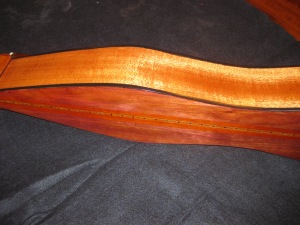Farina’s Dulcimer
This project is something a little different for me, but it was kind of inevitable; the final impetus for making this dulcimer felt like a directive from unseen forces.
Richard Farina was an early and profound influence on me in those formative teenage years when finding something or someone that affirms and enhances your own still developing but unique set of political, spiritual, aesthetic beliefs can be almost overwhelming. When my brother Bo came back from a stint in Texas in the USN, he brought with him a Mimi and Richard Farina record, and I was hooked at first listen. Farina played the dulcimer, but played in a rhythmic and almost feverish style, playing melodies that sound to my ear now like an early recognition of the wave of World music that would come 30 years later.
His lyrics were intelligent and poetic, even in that era of intelligent and poetic lyrics. I read his hilarious novel, Been Down So Long It Looks Like Up To Me, several times in high school, and its style and wit led me to an appreciation of Thomas Pynchon, my favorite writer. Pynchon, reclusive enough to make J.D. Salinger look like Paris Hilton, happened to be the best man at Richard and Mimi’s wedding. Farina himself died in a motorcycle crash two days after his novel was published, at the age of 29. The perfect model for teenage ennui.
Of Cuban and Irish heritage, his meditation on the stigma of “mixed” marriage prevalent at the time, The Quiet Joys of Brotherhood, stands as a model for me of lyrics being made more profound by their simplicity. This version was recorded by Mimi after Richard’s death, with a string arrangement by Peter Schickele, (aka P.D.Q.Bach), that mirrors the deceptive simplicity of the lyrics.
Where gentle tides go rolling by,
Along the salt sea strand
The colors blend and roll as one
Together in the sand.
And often do the winds entwine
To send their distant call,
The quiet joys of brotherhood,
And love is lord of all.
The oak and weed together rise,
Along the common ground.
The mare and stallion light and dark
Have thunder in their sound.
The rainbow tide, the blended flower
Still have my heart in thrall.
The quiet joys of brotherhood,
And love is lord of all.
But men have come to plough the tide,
The oak lies on the ground.
I hear their fires in the fields,
They drive the stallion down.
The roses bleed both light and dark,
The winds do seldom call.
The running sands recall the time
When love was lord of all.
So Richard Farina was the reason behind my buying that dulcimer kit in 1968, that sparked the flood of dulcimers built by my Dad, and written about elsewhere here.
Lately, it had occurred to me to try to build a copy of Farina’s dulcimer, based on a few pictures I had seen on album covers, etc. A couple of years ago I’d read an article about the Australian luthier who built it for him which intrigued me, but didn’t offer as much detail as I’d hoped.
On a visit to Georgia recently I was talking to Bo, who raised the notion of building a dulcimer with construction and detail like you’d find in a guitar, and I mentioned the Farina project I had in mind. As with so many conversations these days, this one was aided by a nearby laptop, and a web search turned up the same old set of pictures, the same article about the luthier, but the only thing new of note was the story about Mimi donating the instrument to the Smithsonian, which had no plans to exhibit it in the near future.
The next day, back in New Jersey, I looked on Facebook, and my other brother ,Lon,had posted to my page(and without any knowledge of our conversation, mind you ) a set of pictures of the documentation by the Smithsonian of the dulcimer being put into the archives, pictures that had been published to the web only hours before. I took this as a sign that could not be ignored,
So I followed the basic ideas of the original as far as shape and dimensions as near as I could determine, but added some flourishes of my own. Interestingly, the scroll was almost exactly like the one I did on my latest cello . A purpleheart and padauk back with a marquetry center strip, banjo tuners instead of ukelele ones, an actual tailpiece instead of screws to wrap the strings around, and more elaborate bindings.I used a zero fret like the original, and I copied the pickguard detail, an absolute necessity to playing in Farina style, and got a little fancy with some tortoise binding that makes it look like an inlaid slab. Rather than the non-continuous fretboard on the original, the fretboard on mine is hollow the whole length, sitting on two rails, and bound with some additional marquetry. Yesterday I strung it up, the moment of exquisite suspense for a luthier. The sound was big and rich, and the box is still humming for a while after you set it down.
My mission having been completed, I can get back to mandos now.







